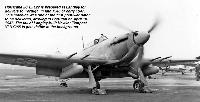Фотографии
-
Flown to the UK by Alferes Lobo Fernandes, Hurricane IIC “624”, bearing the code letters MP-B, was photographed at Langley before its long-range tanks and cannon were removed and its temporary RAF markings were applied for filming at Kenley.
Самолёты на фотографии: Hawker Hurricane - Великобритания - 1935
-
Four of the Portuguese Hurricanes and The Last of The Many - “US-B” - aloft during the filming of the flying sequences for Angels One Five. With filming wrapped by mid-August 1951 the Portuguese Hurricanes were flown back to Espinho to resume their duties with the Aeronautica Militar’s GIAC unit.
Самолёты на фотографии: Hawker Hurricane - Великобритания - 1935
-
Local aviation enthusiast Conceigao e Silva poses in the cockpit of Hurricane IIC “580” at Sintra, near Lisbon. Referred to by the Portuguese as Mk IIBs or Mk IICs, at least 20 of the AM’s wartime Hurricane deliveries were Canadian-built machine-gun-equipped Mk Xs and XIs or cannon-armed Mk XIIs.
Самолёты на фотографии: Hawker Hurricane - Великобритания - 1935
-
Charm school - Alferes (2nd Lt) Pereira Lemos of the Aeronautica Militar gives Rank Organisation starlet Patricia Dainton a tour of his "office” at the Hawker factory at Langley in July 1951. Miss Dainton did not appear in Angels One Five, but was apparently a guest of one of the film’s co-producers.
Самолёты на фотографии: Hawker Hurricane - Великобритания - 1935
-
Air Vice-Marshal The Earl of Bandon shakes hands with Alferes Moura Pinto, the flight commander of the five Portuguese Hurricanes recruited for filming, upon the group’s arrival at Tangmere on July 16, 1951.
Самолёты на фотографии: Hawker Hurricane - Великобритания - 1935
-
Hurricane “633”/MP-C, one of the post-war batch delivered in 1947, taxies out at Sintra. On July 1, 1952, the Army’s Aeronautica Militar and the Navy’s Aviacao Naval were merged to become the Forca Aerea Portuguesa, which then set about equipping with jet-powered Republic F-84G Thunderjets.
Самолёты на фотографии: Hawker Hurricane - Великобритания - 1935
-
Several of the Hurricanes that arrived for the filming were adorned with a distinctive artwork of a cannon-armed fly or mosquito in pilot’s helmet and goggles, above which was the legend “Ou vai ou racha” - “Sink or swim” in Portuguese; if any readers can elaborate, please contact the Editor!
Самолёты на фотографии: Hawker Hurricane - Великобритания - 1935
-
Obsoletely fabulous - Hurricane IIC “646"/MP-G taxies out for another sortie from Sintra, where the MP operational training unit was based from late 1944. Although the Hurricane was completely obsolescent by 1947, it made economic sense for Portugal to acquire more examples of a type that had proved robust, suited to the climate and comparatively cheap and easy to maintain.
Самолёты на фотографии: Hawker Hurricane - Великобритания - 1935
-
The Portuguese pilots chat with RAF officers Wg Cdr T.B. “Barney” Beresford (second left), who was involved in the filming, and Gp Capt Tom Prickett (furthest right) at Tangmere. Hurricane “554”/VX-O was one of two in the group from VX, the other being “544”/VX-E. The other three were coded MP: “601” (S); “624” (B) and “600” (unknown).
Самолёты на фотографии: Hawker Hurricane - Великобритания - 1935
-
Регистрационный номер: NX285 Hurricane IIC LF422 is prepared at Langley for delivery to Portugal in late 1946 or early 1947. This machine was one of the first post-war batch to be delivered, arriving in Portugal on April 10, 1947. The tail of Langley-built Hawker Tempest VI NX285 is just visible in the background.
Самолёты на фотографии: Hawker Hurricane - Великобритания - 1935Hawker Tempest - Великобритания - 1943
-
With their Hurricanes painted in vintage camouflage and bearing the "US” codes of the RAF’s No 56 Sqn, four of the Portuguese pilots discuss the flying sequences at Kenley with Barney Beresford (second left) and Hawker test pilot Frank Murphy (third from right), who flew PZ865/G-AMAU (fourth Hurricane from left in line-up).
Самолёты на фотографии: Hawker Hurricane - Великобритания - 1935
Статьи
- -
- D.Crotty - The Singapore Express
- E.Young - A Hard Rain
- F.Merriam - "Air-Itis" /Echoes from Dawn Skies/ (8)
- G.Alegi - Ninety Seconds over Tobruk
- J.Franzi - Riding the Storm /An eye for detail/
- J.Matos - Anjos um Cinco!
- J.Stroud - The South Bank Show /The John Stroud Archive/
- L.Hellstrom - To Africa in a Barrel
- M.Hiscock - The Miracle of Flight 843
- N.Stroud - RumPunch
- P.Davidson - Off the Beaten Track...
- P.Jarrett - Lost & Found
- T.Singfield - The Light Brigade
- V.Kotelnikov - Russia's Real Flying Tanks










